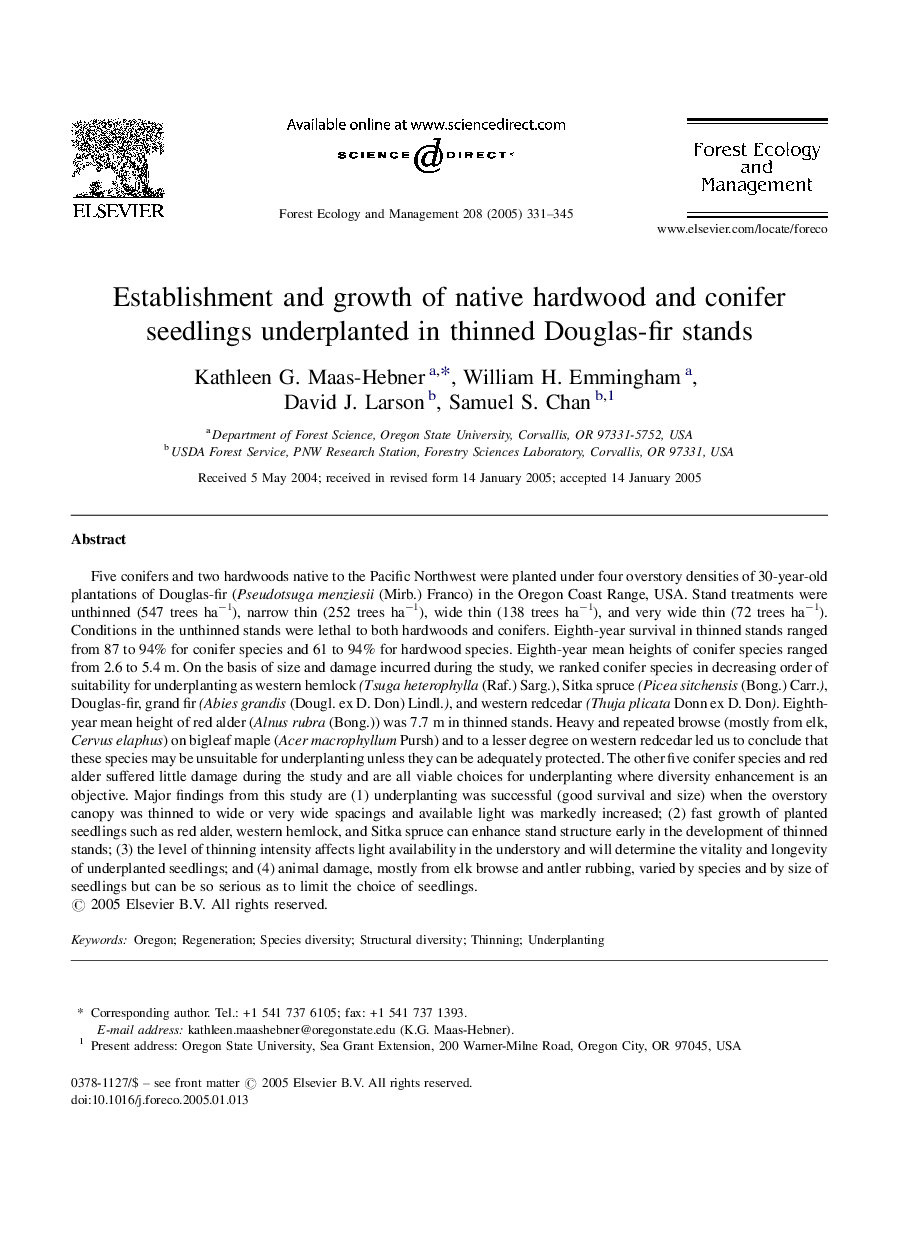| کد مقاله | کد نشریه | سال انتشار | مقاله انگلیسی | نسخه تمام متن |
|---|---|---|---|---|
| 9620426 | 159409 | 2005 | 15 صفحه PDF | دانلود رایگان |
عنوان انگلیسی مقاله ISI
Establishment and growth of native hardwood and conifer seedlings underplanted in thinned Douglas-fir stands
دانلود مقاله + سفارش ترجمه
دانلود مقاله ISI انگلیسی
رایگان برای ایرانیان
کلمات کلیدی
موضوعات مرتبط
علوم زیستی و بیوفناوری
علوم کشاورزی و بیولوژیک
بوم شناسی، تکامل، رفتار و سامانه شناسی
پیش نمایش صفحه اول مقاله

چکیده انگلیسی
Five conifers and two hardwoods native to the Pacific Northwest were planted under four overstory densities of 30-year-old plantations of Douglas-fir (Pseudotsuga menziesii (Mirb.) Franco) in the Oregon Coast Range, USA. Stand treatments were unthinned (547 trees haâ1), narrow thin (252 trees haâ1), wide thin (138 trees haâ1), and very wide thin (72 trees haâ1). Conditions in the unthinned stands were lethal to both hardwoods and conifers. Eighth-year survival in thinned stands ranged from 87 to 94% for conifer species and 61 to 94% for hardwood species. Eighth-year mean heights of conifer species ranged from 2.6 to 5.4Â m. On the basis of size and damage incurred during the study, we ranked conifer species in decreasing order of suitability for underplanting as western hemlock (Tsuga heterophylla (Raf.) Sarg.), Sitka spruce (Picea sitchensis (Bong.) Carr.), Douglas-fir, grand fir (Abies grandis (Dougl. ex D. Don) Lindl.), and western redcedar (Thuja plicata Donn ex D. Don). Eighth-year mean height of red alder (Alnus rubra (Bong.)) was 7.7Â m in thinned stands. Heavy and repeated browse (mostly from elk, Cervus elaphus) on bigleaf maple (Acer macrophyllum Pursh) and to a lesser degree on western redcedar led us to conclude that these species may be unsuitable for underplanting unless they can be adequately protected. The other five conifer species and red alder suffered little damage during the study and are all viable choices for underplanting where diversity enhancement is an objective. Major findings from this study are (1) underplanting was successful (good survival and size) when the overstory canopy was thinned to wide or very wide spacings and available light was markedly increased; (2) fast growth of planted seedlings such as red alder, western hemlock, and Sitka spruce can enhance stand structure early in the development of thinned stands; (3) the level of thinning intensity affects light availability in the understory and will determine the vitality and longevity of underplanted seedlings; and (4) animal damage, mostly from elk browse and antler rubbing, varied by species and by size of seedlings but can be so serious as to limit the choice of seedlings.
ناشر
Database: Elsevier - ScienceDirect (ساینس دایرکت)
Journal: Forest Ecology and Management - Volume 208, Issues 1â3, 5 April 2005, Pages 331-345
Journal: Forest Ecology and Management - Volume 208, Issues 1â3, 5 April 2005, Pages 331-345
نویسندگان
Kathleen G. Maas-Hebner, William H. Emmingham, David J. Larson, Samuel S. Chan,